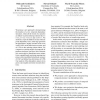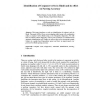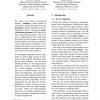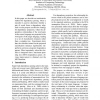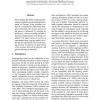ACL
2012
12 years 10 months ago
2012
Long-span features, such as syntax, can improve language models for tasks such as speech recognition and machine translation. However, these language models can be difficult to u...
ACL
2012
12 years 10 months ago
2012
We propose a new approach to characterizing the timeline of a text: temporal dependency structures, where all the events of a narrative are linked via partial ordering relations l...
EMNLP
2011
13 years 7 months ago
2011
We present a quasi-synchronous dependency grammar (Smith and Eisner, 2006) for machine translation in which the leaves of the tree are phrases rather than words as in previous wor...
CICLING
2011
Springer
13 years 11 months ago
2011
Springer
This paper introduces a work on identification of conjunct verbs in Hindi. The paper will first focus on investigating which noun-verb combination makes a conjunct verb in Hindi us...
ACL
2011
13 years 11 months ago
2011
Counts from large corpora (like the web) can be powerful syntactic cues. Past work has used web counts to help resolve isolated ambiguities, such as binary noun-verb PP attachment...
ACL
2011
13 years 11 months ago
2011
Nested event structures are a common occurrence in both open domain and domain specific extraction tasks, e.g., a “crime” event can cause a “investigation” event, which c...
EMNLP
2009
14 years 5 months ago
2009
We connect two scenarios in structured learning: adapting a parser trained on one corpus to another annotation style, and projecting syntactic annotations from one language to ano...
ACL
2010
14 years 5 months ago
2010
In this paper we describe an intuitionistic method for dependency parsing, where a classifier is used to determine whether a pair of words forms a dependency edge. And we also pro...
ACL
2006
14 years 9 months ago
2006
We investigate the utility of supertag information for guiding an existing dependency parser of German. Using weighted constraints to integrate the additionally available informat...
LREC
2008
14 years 9 months ago
2008
This paper presents some preliminary results of our dependency parser for Thai. It is part of an ongoing project in developing a syntactically annotated Thai corpus. The parser ha...

